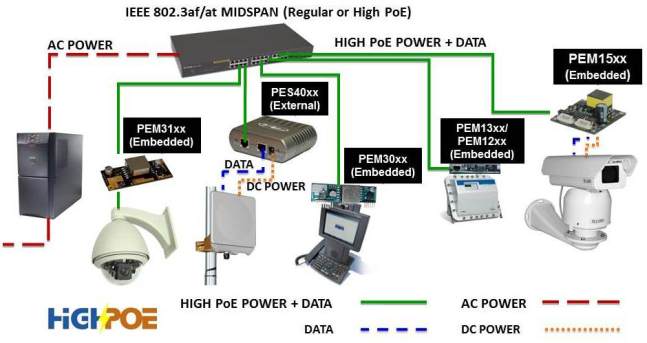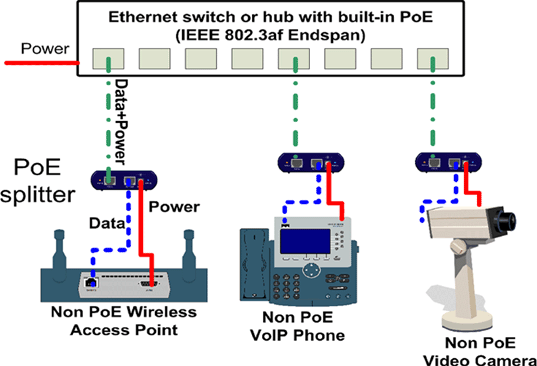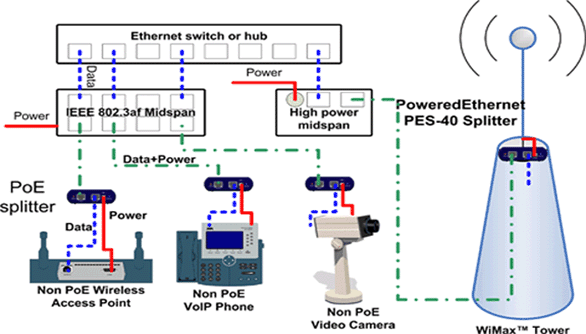Frequently Asked Questions About Power Over Ethernet Technology
Download PoE White Paper in PDF Format ![]()
-
How is the power extracted from the cable ? What is a Powered Device (PD) ?
-
How does the PSE know that the connected device must be PoE enabled ?
-
How to use PoE with non-PoE devices ? What is a "PoE Splitter" ?
-
What devices can I power using this interim "High Power" PoE ? ?
-
What type of POE Power Supplies (PSE) can be used with the PES40 splitters ?
-
Can I use the PES 40 splitters for lower power (<= 13W) applications ?
-
Do the PES 40 splitters work with non IEEE802.3af compliant PSE´s ?
-
Does the PES 40 splitters have any special safety and protection ?
-
What types of power injection methods do the PES 40 splitters support ?
What is Power over Ethernet (PoE) technology ?
PoE is a technology for wired Ethernet, the most widely installed local area network technology in use today. PoE allows the electrical power necessary for the operation of each end-device to be carried by data cables along with the data, rather than by separate power cords. Thus, it minimizes the number of wires used to install the network, resulting in lower cost, less downtime, easier maintenance and greater installation flexibility.

Why use PoE ? What are the benefits ?
All Ethernet/internet appliances require both data connectivity and a power supply. Until now, we laid two sets of cables. PoE allows the data and power to be carried on one single cable. There are many benefits to using PoE, but in most cases the overriding reason is cost.
As an example :
If the cost of running an Ethernet cable to an end device such as a wireless access point, VoIP phone, video security camera, etc., is about $100, the cost of running an electrical conduit to power the end device will be an additional $400.
PoE technology as an alternative, will require you to install a PoE Power Sourcing Equipment (PSE). The PSE combines the data and power, and sends it through the Ethernet cable. The power from the cable can then be extracted at the endpoint by a PoE Powered Device (PD) to operate the end-point equipment. The total cost of investment could be as low as $60, which is a significant savings over the $400.
Other benefits of Power over Ethernet technology
-
Simplifies installation and saves space - Only one set of wires to bring to your appliance.
-
Saves time and money - There is no need to pay for an expensive electrician, or delay your installation to meet the electrician's schedule.
-
Minimal disruption to the workplace - The appliance can be easily moved, to wherever you can lay a LAN cable or have already laid a LAN cable.
-
Safer - No high voltage main wires in remote locations.
-
Reliability - Connecting a central UPS ensures power to the appliance during mains power failure.
-
Easy management - You can use SNMP network management infrastructure to monitor and control the appliances, and even shut down or reset remotely
-
Flexibility - In wireless LAN systems it simplifies the RF survey task, as the access point can easily be moved and wired in.
How is power put in to Ethernet cables ? What is a PSE ?
The power can be added to the Ethernet cable by a Power Sourcing Equipment (PSE) in one of two methods.
Endspan - The Ethernet switch or hub has a built-in power source as shown below

Midspan - The power is be added to the cable after the switch using a PSE as shown below

How is the power extracted from the cable ? What is a Powered Device (PD) ?
In a manner similar to injecting the power along with the data, there is a reverse process of extracting the power and separating from the data. Any PoE enabled end-device such as an Access Point, IP Camera, VoIP phone, etc., is called a Powered Device (PD).
 top
top
How does the PSE know that the connected device must be PoE enabled ?
In order to prevent damage to non-PoE enabled equipment, the PSE must verify the presence of PoE enabled equipment at the other end of the Ethernet cable. Active PSE´s have an elaborate conforming signature verification mechanism before it supplies the power on the line. Passive injectors, will not normally confirm the presence of a PoE PD, before supplying power, thus running the risk of damage.
 top
top
How to use PoE with non-PoE devices ? What is a "PoE Splitter" ?
You can use a device called a "PoE splitter" or "PoE adapter". The PoweredEthernet™ PES-40 series is such a device. The splitter performs the Powered Device (PD) function of separating the power and data and provides data and power separately to the non-PoE enabled device.
 top
top
The IEEE802.3af is the formally approved standard that governs the operation of Power Over Ethernet technology. It was approved the IEEE Standards Board on 12-June, 2003. Choosing PoE equipment which conform to this standard, ensures inter-operability of the equipment.
 top
top
What are the limits of the current IEEE802.3af standard ?
The current standard limits the maximum current on the Ethernet cable to 350 milli-amperes (mA), and provides for a maximum end-point device power consumption of 12.95 watts. The maximum length of the Ethernet cable between switch and equipment is 100 meters or 328 feet.
 top
top
What is IEEE802.3at ? What is "PoE Plus" ?
The current IEEE802.3af standard limits the maximum output power to 12.95 Watts at the PD end point. IEEE has constituted a task force to develop a formal standard to raise this limit to 30 Watts and 60 Watts. The new standard is expected to be called IEEE802.3at.
 top
top
How to power a device greater than 12.95 watts ?
This is exactly the point being discussed right now by the IEEE task force for "PoE Plus". Since the time the original standard was established, there have been many changes in the available network infrastructure and it is now possible exceed the original current limit of 350mA and inject up to 700mA.
Certain PSE vendors like Phihong, PowerDsine, and Panduit, have developed "higher power" active injectors, which conform to all aspects of the IEEE802.3af standard, except injecting power at a higher current and the upper band of the allowed voltage range, hence higher power.
Infomart´s PoweredEthernet™ PES-40 splitters, leverage this new higher power technology to provide output loads up to 30 watts.
 top
top
What devices can I power using this interim "High Power" PoE ?
You can use Infomart´s PoweredEthernet™ PES-40 splitters to power legacy high power Ethernet devices like Pan-Tilt-Zoom (PTZ) video surveillance IP cameras, certain thin client workstations, POS Terminals, Video IP phones, BlueTooth™ access points, the new generation 802.11n wireless access points. Essentially ANY Ethernet device with a power consumption of 30W or lower.
 top
top
What are some possible uses of PoE technology ?
There is no shortage of potential uses. The only limitation is imagination and power requirements. Any Ethernet device, within the power norms, can be powered using PoE technology. Some examples :
| • VoIP telephones | • Wireless LAN Access Points |
| • Bluetooth® Access Points | • Smart signs |
| • Point of information systems | • Point of Sale systems |
| • Thin clients | • VoIP telephones |
| • Access control systems | • RFID systems |
| • WinMax™ infrastructure | • Pan-Tilt-Zoom (PTZ) video cameras |
Are the PES40 splitters IEEE802.3af compliant ?
Yes. The PES 40 splitters have been tested at the University of New Hampshire, Inter-operability Lab (UNH-IOL) for IEEE802.3af complaint.
 top
top
What type of POE Power Supplies (PSE) can be used with the PES40 splitters ?
The PES 40 splitters are IEEE802.3af compliant and will work with any IEEE802.3af PSE. They also work best with PSE like the Phihong POE30U and PowerDsine 7001 which are designed to deliver higher power while still being IEEE802.3af compliant.
 top
top
Can I use the PES 40 splitters for lower power (<= 13W) applications ?
Yes. PES 40 splitters modules have been designed to offer high efficiency performance from 5 Watts to 30 Watts, making them your ideal choice of solutions for all your POE needs.
 top
top
Do the PES 40 splitters work with non IEEE802.3af compliant PSE´s ?
It will have to be tried on a case-by-case basis. We cannot confirm performance.
 top
top
Does the PES 40 splitters have any special safety and protection ?
The PES 40 splitter offers 1500v isolation between input and output and features a special protection which allows continuous output short-circuit. The PES40 also offers input under and over voltage, and output overload protection offered by most splitters.
 top
top
What types of power injection methods do the PES 40 splitters support ?
The PES 40 splitters supports both IEEE802.3af Mode-A and Mode-B power injection on either the "data/signal pair" (pins 1,2,3,6), or on the "spare pair" (pin 4,5,7,8).
The PES 40 splitter can also support 4-pair injection without input load balancing, but offers IEEE802.3af PoE detection, signature and classification, only on, any one pair.
 top
top
Where can I obtain more information ?
You can visit the following websites :
www.poweroverethernet.com or www.poweredethernet.com
Or you can contact :
Infomart (India) Pvt. Ltd.
